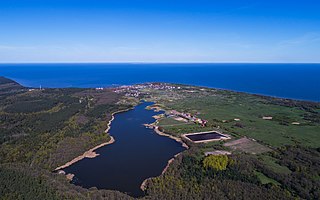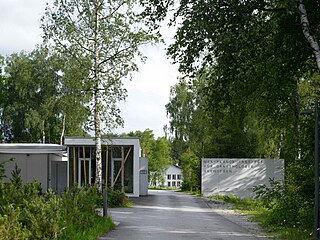
A Heligoland trap is a large, building-sized, funnel-shaped, rigid structure of wire mesh or netting used to trap birds, so that they can be banded or otherwise studied by ornithologists.

The Curonian (Courish) Spit is a 98-kilometre (61 mi) long, thin, curved sand-dune spit that separates the Curonian Lagoon from the Baltic Sea. It is a UNESCO World Heritage Site shared by Lithuania and Russia. Its southern portion lies within Kaliningrad Oblast of Russia, and its northern within southwestern Klaipėda County of Lithuania.

The Kaiser Wilhelm Society for the Advancement of Science was a German scientific institution established in the German Empire in 1911. Its functions were taken over by the Max Planck Society. The Kaiser Wilhelm Society was an umbrella organisation for many institutes, testing stations, and research units created under its authority.

Rybachy is a rural settlement in Zelenogradsky District of Kaliningrad Oblast, Russia, located on the Curonian Spit. As of 2010 it has about 839 residents. It was formerly known for the Rossitten Bird Observatory and the Rossitten gliding school.

Nemunas Delta is the Lithuanian name for the Neman (Nemunas) River Delta, in Lithuania. Prior to post-World War II border changes, it was known in German as the Memel Niederung, as the Neman was for centuries called the Memel in German.
Viktor Rafaelyevich Dolnik was a Russian ornithologist who administered the Rybachy Biological Station for 22 years. Haemoproteus dolniki is named after him.

Heinrich Gätke was a German ornithologist and artist.

The Heligoland Bird Observatory, one of the world's first ornithological observatories, is operated by the Ornithologische Arbeitsgemeinschaft Helgoland e.V., a non-profit organization which was founded in 1891 to support research on the fauna of Heligoland, a small German archipelago, comprising the islands of Heligoland and Düne, in the Heligoland Bight of the North Sea. The principal research focus is on bird migration through banding studies. Over 400 species have been recorded. OAG Helgoland produces an annual bird report.

Johannes Wilhelm Thienemann was a German ornithologist and pastor who established the Rossitten Bird Observatory, the world's first dedicated bird ringing station where he conducted research and popularized bird study.

Kurt Ehrenreich Floericke was a German naturalist and author of numerous popular science books. He also edited the Kosmos magazine in Stuttgart from 1907. An early advocate of bird protection, he sought the establishment of a bird sanctuary on Lake Constance.

Events relating to birding and ornithology that occurred in 1901 include:

Lev Osipovich Belopolsky was a Soviet ornithologist and marine biologist who founded the Biological Station of the Zoological Institute in Rybachiy. He worked extensively on polar ecology, especially in the Barents Sea and the Curonian Spit, and produced works on the biology of the birds of the region.

Friedrich Tischler was a German lawyer and ornithologist who studied the birds of East Prussia and published a two volume work on them. He was working on another major work which was destroyed during the Second World War. He committed suicide along with his wife when Soviet troops marched into Germany.

Ernst Paul Theodor Schüz was a German ornithologist and a curator at the natural history museum in Stuttgart. He was known for his extensive work at the Rossiten bird observatory, particularly for his studies on white storks.
Baron Johann Nikolaus von Bodman was a German nobleman, ornithologist and bird conservationist who helped establish the Radolfzell bird observatory at his castle in Möggingen. It was incorporated into the Max Planck Society in 1949 and added to the Max Planck Institute for Behavioural Physiology in 1959.

The Max Planck Institute for Ornithology was a non-university research institution under the sponsorship of the Max Planck Society. As of 1 January 2023, it merged with the Max Planck Institute for Neurobiology (MPIN) to form the new Max Planck Institute for Biological Intelligence (MPI-BI). The MPIO was located in Seewiesen, which belongs to the municipality of Pöcking in Upper Bavaria.
Eberhard Gwinner was a German ornithologist and founding director of the Max-Planck Institute for ornithology. He specialized in the study of annual rhythms, their endocrine control, and biological clocks in birds.

Johann Friedrich Lindner was a German pastor and ornithologist. He was among the first to notice the intensity of migratory birds over the Curonian Spit and particularly Rossiten which was later developed into a bird observatory by his school friend Johannes Thienemann.

August Wilhelm Thienemann was a German pastor, ornithologist and conservationist. He was the father of Johannes Wilhelm Thienemann, the pioneer of bird ringing in Germany and the founder of the Rossiten bird observatory.
























